SUBARU BRZ 2017 1.G Owners Manual
Manufacturer: SUBARU, Model Year: 2017, Model line: BRZ, Model: SUBARU BRZ 2017 1.GPages: 540, PDF Size: 6.88 MB
Page 251 of 540

249 2-4. Using other driving systems
2
When driving
WARNING
■When using the rear view camera
●Since the rear view camera uses a wide-angle lens, the image on the
screen will be different from the actual view in terms of distance.
●Since the range of the image displayed on the screen is limited, you
should always check the area behind the vehicle and the surrounding area
with your eyes and mirrors, and move backward at a slow speed. Moving
backward only by checking the rear view image from the rear view camera
could lead to an accident.
●Do not disassemble or modify the rear view camera, switch or wiring. If
smoke comes from any of the parts or you smell a strange odor, stop using
the rear view camera immediately. Contact your SUBARU dealer for an
inspection. Continued use may result in accident, fire or electric shock.
●Do not expose the rear view camera or wiring to an open flame as damage
or a fire may occur.
●Do not use the system if the trunk is open.
Page 252 of 540

250 2-4. Using other driving systems
CAUTION
■How to use the rear view camera
●When washing your vehicle with a high-pressure washer, do not allow the
water to contact the rear view camera directly. Entry of water into the cam-
era lens may result in condensation on the lens, malfunction, fire or elec-
tric shock.
●Since the rear view camera is a precision device, do not subject it to
strong impacts. Otherwise, malfunction, fire or electric shock may occur.
●If mud or snow sticks to or is frozen on the rear view camera, very carefully
remove it. Otherwise, damage to the rear view camera may cause a fire or
electric shock. Pour water or lukewarm water over the rear view camera to
remove mud and ice, and wipe it with a soft, dry cloth.
●When replacing a fuse, be sure to use a fuse with the specified rating. Use
of a fuse with a different rating may result in a malfunction.
●If the rear view camera is used for a long time while the engine is not run-
ning, the battery may become completely discharged.
Page 253 of 540
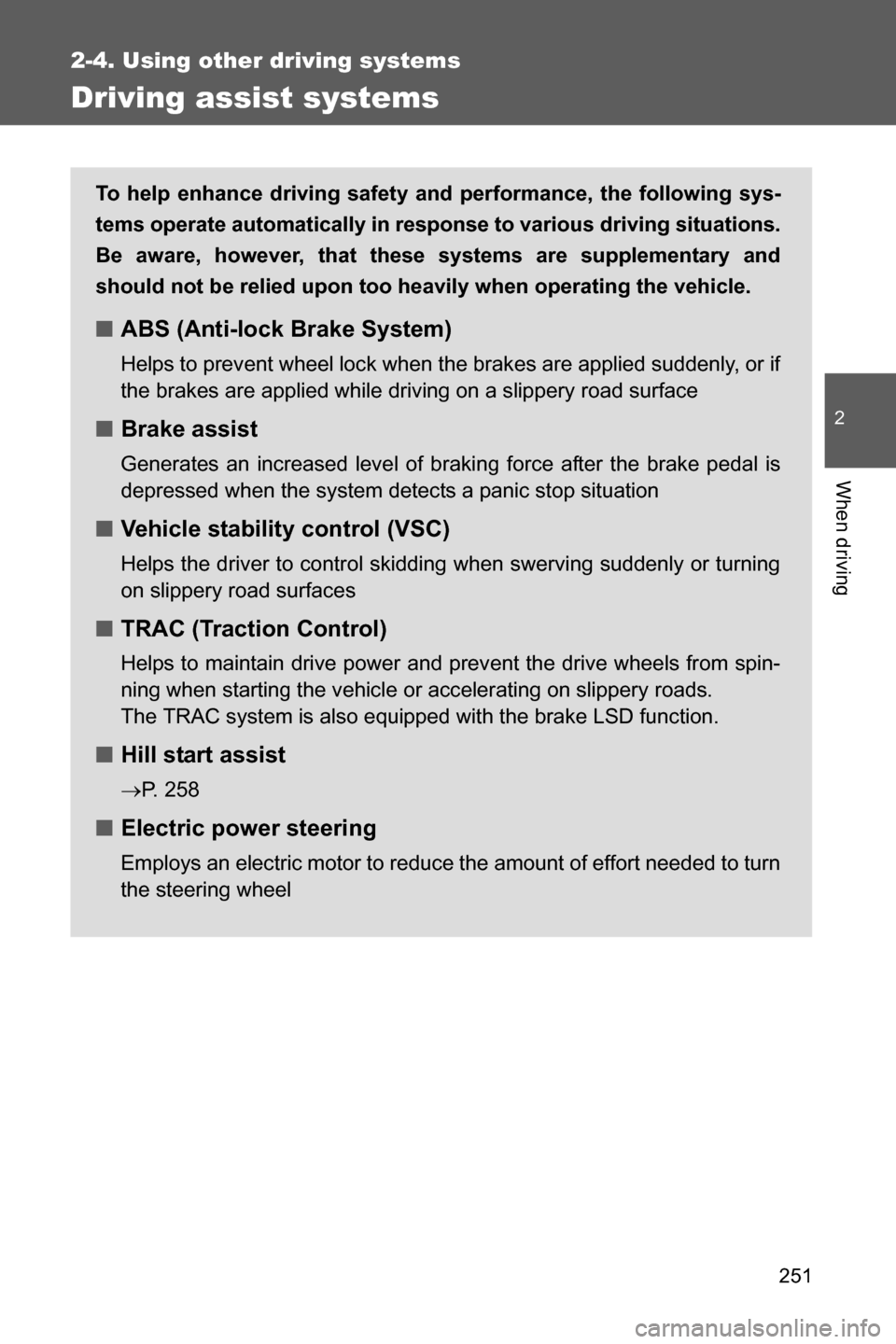
251
2-4. Using other driving systems
2
When driving
Driving assist systems
To help enhance driving safety and performance, the following sys-
tems operate automatically in response to various driving situations.
Be aware, however, that these systems are supplementary and
should not be relied upon too heavily when operating the vehicle.
■ABS (Anti-lock Brake System)
Helps to prevent wheel lock when the brakes are applied suddenly, or if
the brakes are applied while driving on a slippery road surface
■Brake assist
Generates an increased level of braking force after the brake pedal is
depressed when the system detects a panic stop situation
■Vehicle stability control (VSC)
Helps the driver to control skidding when swerving suddenly or turning
on slippery road surfaces
■TRAC (Traction Control)
Helps to maintain drive power and prevent the drive wheels from spin-
ning when starting the vehicle or accelerating on slippery roads.
The TRAC system is also equipped with the brake LSD function.
■Hill start assist
�oP. 258
■Electric power steering
Employs an electric motor to reduce the amount of effort needed to turn
the steering wheel
Page 254 of 540
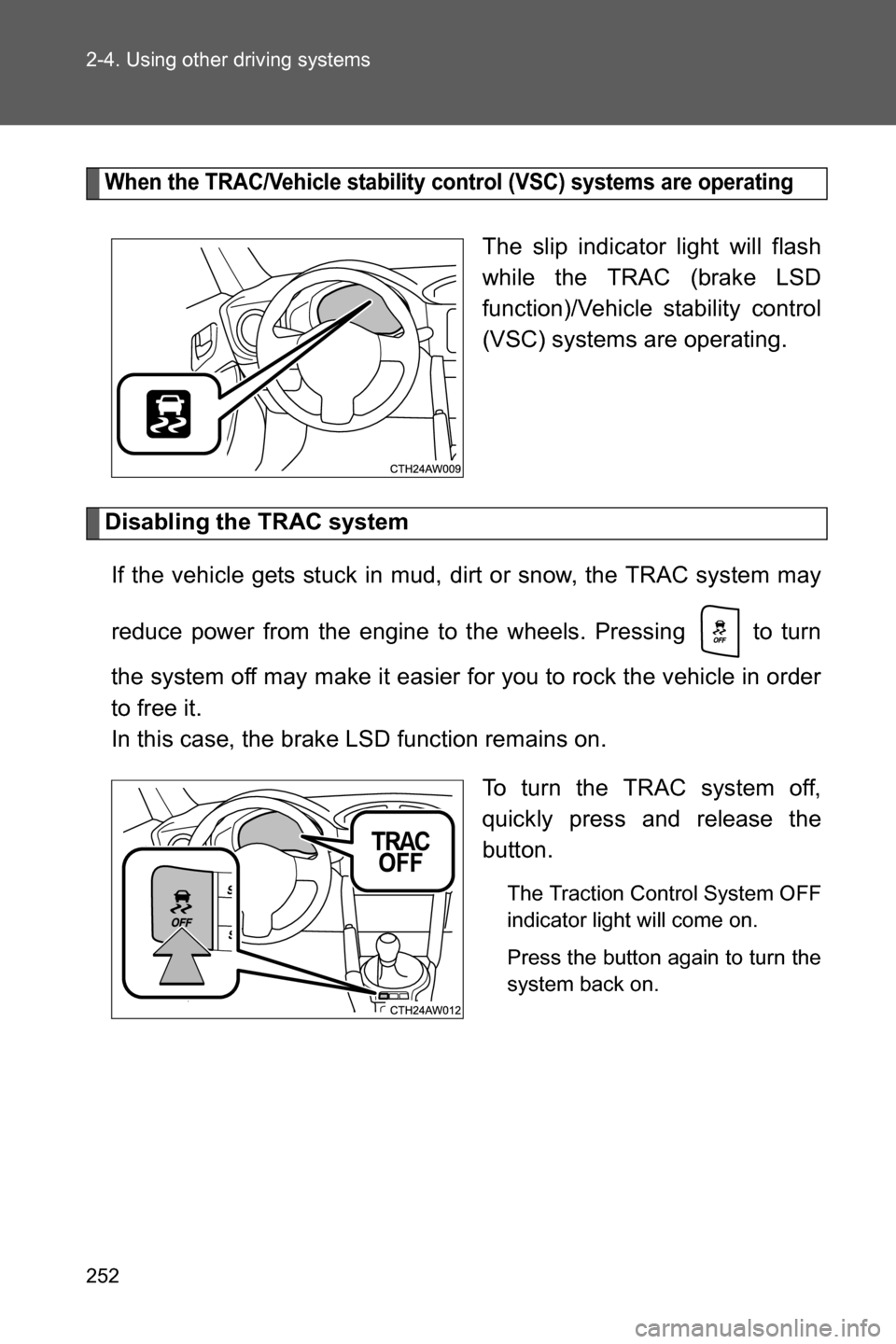
252 2-4. Using other driving systems
When the TRAC/Vehicle stability control (VSC) systems are operating
The slip indicator light will flash
while the TRAC (brake LSD
function)/Vehicle stability control
(VSC) systems are operating.
Disabling the TRAC system
If the vehicle gets stuck in mud, dirt or snow, the TRAC system may
reduce power from the engine to the wheels. Pressing to turn
the system off may make it easier for you to rock the vehicle in order
to free it.
In this case, the brake LSD function remains on.
To turn the TRAC system off,
quickly press and release the
button.
The Traction Control System OFF
indicator light will come on.
Press the button again to turn the
system back on.
Page 255 of 540
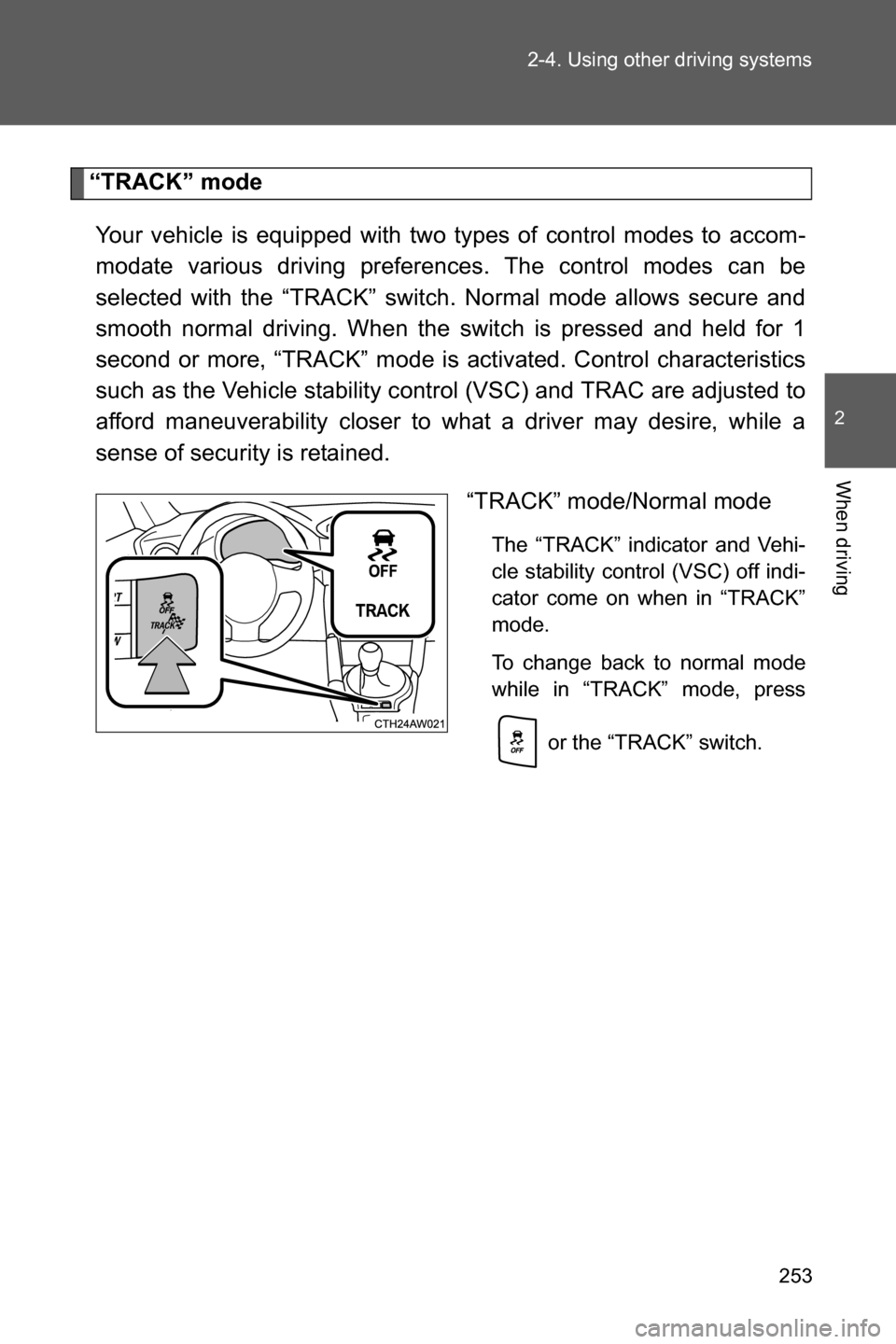
253 2-4. Using other driving systems
2
When driving
“TRACK” mode
Your vehicle is equipped with two types of control modes to accom-
modate various driving preferences. The control modes can be
selected with the “TRACK” switch. Normal mode allows secure and
smooth normal driving. When the switch is pressed and held for 1
second or more, “TRACK” mode is activated. Control characteristics
such as the Vehicle stability control (VSC) and TRAC are adjusted to
afford maneuverability closer to what a driver may desire, while a
sense of security is retained.
“TRACK” mode/Normal mode
The “TRACK” indicator and Vehi-
cle stability control (VSC) off indi-
cator come on when in “TRACK”
mode.
To change back to normal mode
while in “TRACK” mode, press
or the “TRACK” switch.
Page 256 of 540
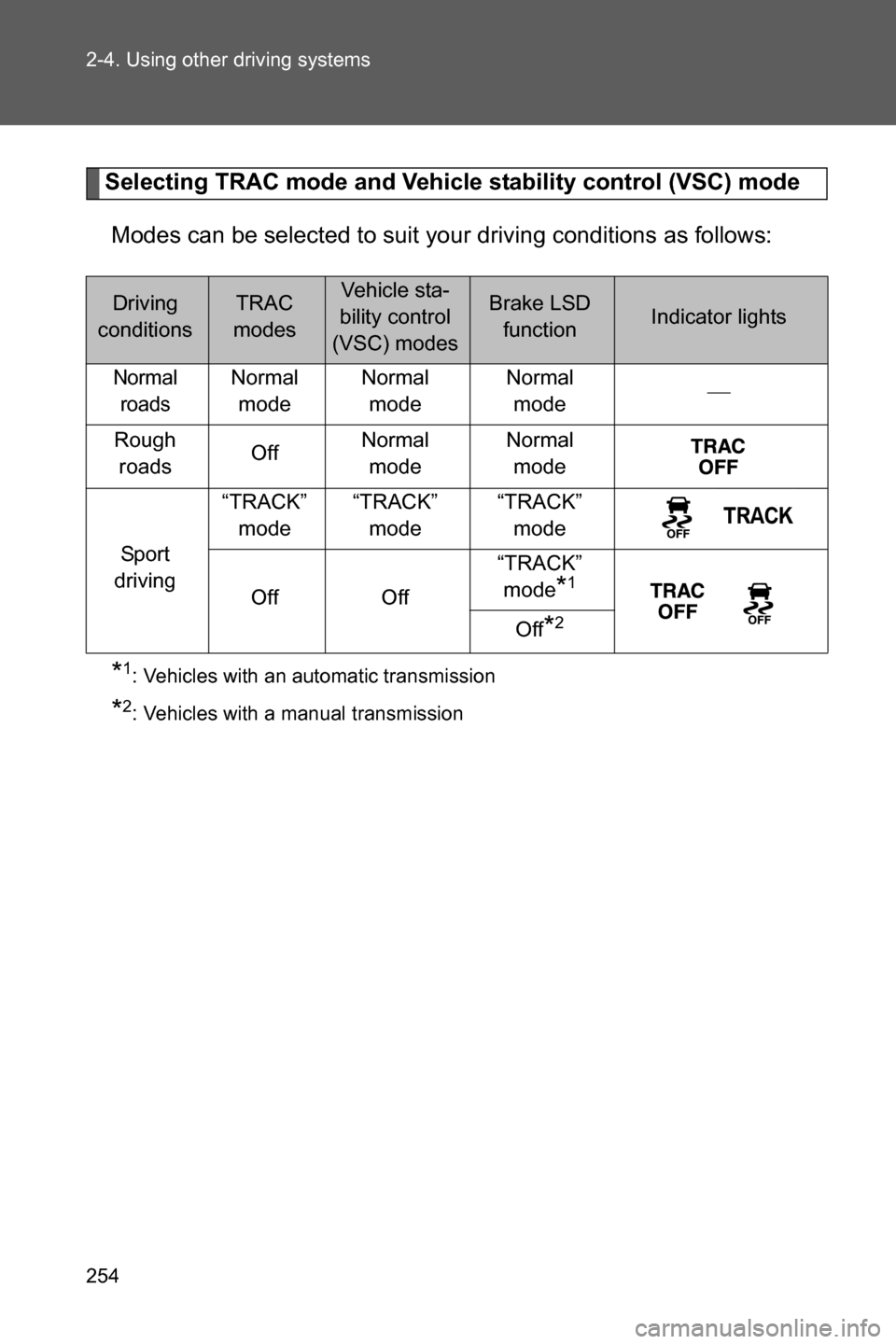
254 2-4. Using other driving systems
Selecting TRAC mode and Vehicle stability control (VSC) mode
Modes can be selected to suit your driving conditions as follows:
*1:Vehicles with an automatic transmission
*2:Vehicles with a manual transmission
Driving
conditionsTRAC
modesVehicle sta-
bility control
(VSC) modesBrake LSD
functionIndicator lights
Normal
roadsNormal
modeNormal
modeNormal
mode�
Rough
roadsOffNormal
modeNormal
mode
Sport
driving“TRACK”
mode“TRACK”
mode“TRACK”
mode
Off Off“TRACK”
mode
*1
Off*2
Page 257 of 540

255 2-4. Using other driving systems
2
When driving
■Turning off both TRAC and Vehicle stability control (VSC) systems
To turn the TRAC and Vehicle stability control (VSC) systems off, press and
hold for more than 3 seconds while the vehicle is stopped.
The Traction Control System OFF indicator light and the Vehicle stability
control (VSC) off indicator light will come on.
However, on vehicles with an automatic transmission, the brake LSD func-
tion will remain on.
Press the button again to turn the systems back on.
■Automatic reactivation of TRAC and Vehicle stability control (VSC) sys-
tems
After turning the TRAC and Vehicle stability control (VSC) systems off, the
systems will be automatically reactivated in the following situations:
●Vehicles without a keyless access with push button start system: When
the engine switch is turned to “LOCK” position
●Vehicles with a keyless access with push button start system: When the
push-button ignition switch is turned off
●If only the TRAC system is turned off, the TRAC will turn on when vehicle
speed is more than approximately 31 mph (50 km/h).
If both the TRAC and Vehicle stability control (VSC) systems are turned
off, automatic reactivation will not occur when vehicle speed increases.
■Automatic deactivation of “TRACK” mode
Vehicles without a keyless access with push button start system
When the engine switch is turned to “LOCK” position after driving in
“TRACK” mode, the mode is automatically deactivated.
Vehicles with a keyless access with push button start system
When the push-button ignition switch is turned off after driving in “TRACK”
mode, the mode is automatically deactivated.
■Sounds and vibrations caused by the ABS, brake assist, TRAC and
Vehicle stability control (VSC) systems
●A sound may be heard from the engine compartment when the brake
pedal is depressed repeatedly, when the engine is started or just after the
vehicle begins to move. This sound does not indicate that a malfunction
has occurred in any of these systems.
Page 258 of 540

256 2-4. Using other driving systems
●Any of the following conditions may occur when the above systems are
operating. None of these indicates that a malfunction has occurred.
• Vibrations may be felt through the vehicle body and steering.
• A motor sound may be heard after the vehicle comes to a stop.
• The brake pedal may pulsate slightly after the ABS is activated.
• The brake pedal may move down slightly after the ABS is activated.
■Electric power steering operation sound
When the steering wheel is operated, a motor sound (whirring sound) may
be heard. This does not indicate a malfunction.
■Reduced effectiveness of the electric power steering system
The effectiveness of the electric power steering system is reduced to pre-
vent the system from overheating when there is frequent steering input over
an extended period of time. The steering wheel may feel heavy as a result.
Should this occur, refrain from excessive steering input or stop the vehicle
and turn the engine off. The electric power steering system should return to
normal after a little while.
WARNING
■The ABS does not operate effectively when
●Tires with inadequate gripping ability are used (such as excessively worn
tires on a snow covered road).
●The vehicle hydroplanes while driving at high speed on wet or slick roads.
■Stopping distance when the ABS is operating may exceed that of nor-
mal conditions
The ABS is not designed to shorten the vehicle’s stopping distance. Always
maintain a safe distance from the vehicle in front of you in the following situ-
ations:
●When driving on dirt, gravel or snow-covered roads
●When driving with tire chains
●When driving over bumps in the road
●When driving over roads with potholes or uneven surfaces
Page 259 of 540

257 2-4. Using other driving systems
2
When driving
WARNING
■TRAC may not operate effectively when
Directional control and power may not be achievable while driving on slip-
pery road surfaces, even if the TRAC system is operating.
Do not drive the vehicle in conditions where stability and power may be lost.
■When the Vehicle stability control (VSC) and/or brake LSD function is
activated
The slip indicator light flashes. Always drive carefully. Reckless driving may
cause an accident. Exercise particular care when the indicator light flashes.
■When the TRAC/Vehicle stability control (VSC) systems are turned off
Be especially careful and drive at a speed appropriate to the road condi-
tions. As these are the systems to help ensure vehicle stability and driving
force, do not turn the TRAC/Vehicle stability control (VSC) systems off
unless necessary.
■Replacing tires
Make sure that all tires are of the specified size, brand, tread pattern and
total load capacity. In addition, make sure that the tires are inflated to the
recommended tire inflation pressure level.
The ABS, TRAC and Vehicle stability control (VSC) systems will not function
correctly if different tires are installed on the vehicle.
Contact your SUBARU dealer for further information when replacing tires or
wheels.
■Handling of tires and suspension
Using tires with any kind of problem or modifying the suspension will affect
the driving assist systems, and may cause a system to malfunction.
Page 260 of 540
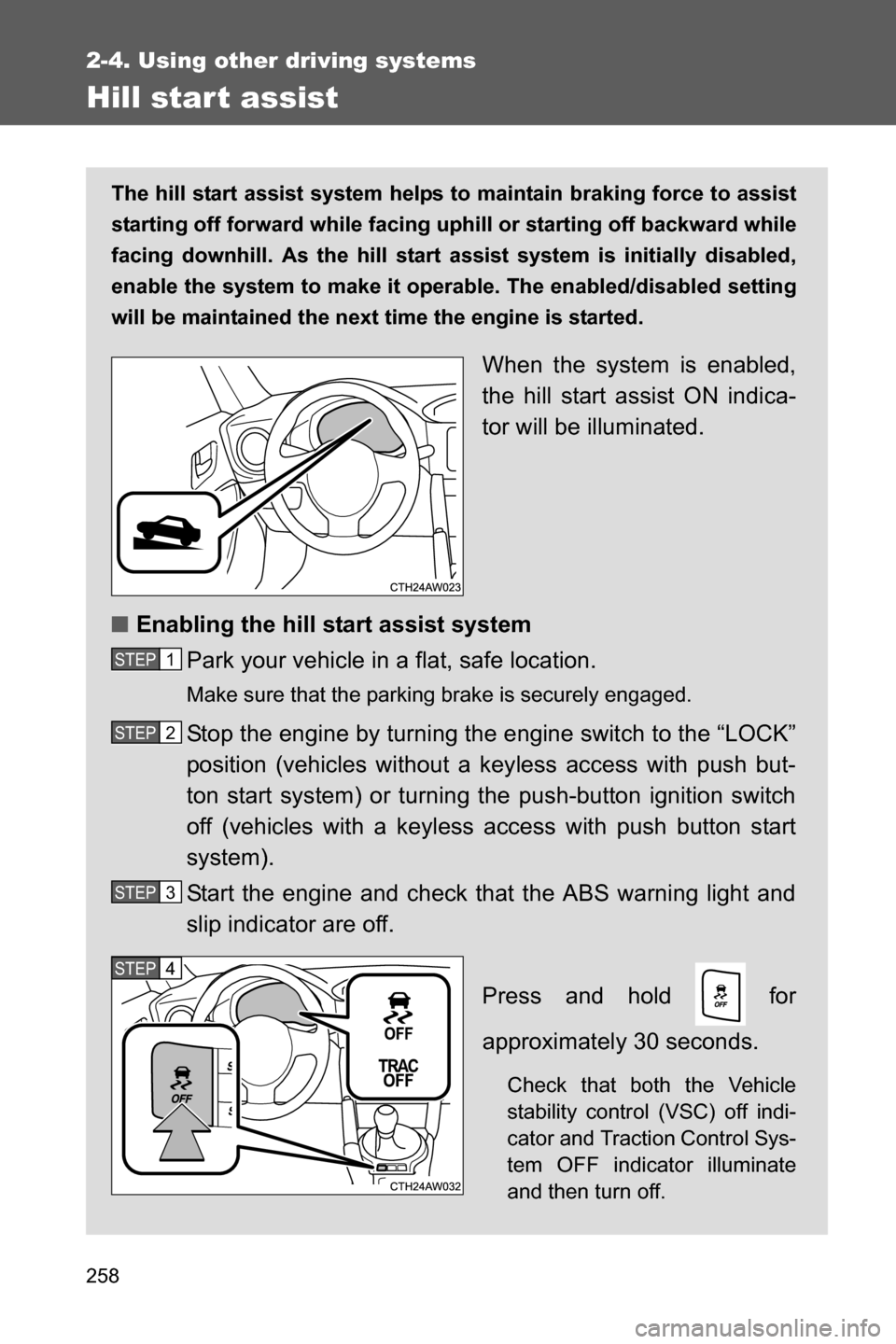
258
2-4. Using other driving systems
Hill star t assist
The hill start assist system helps to maintain braking force to assist
starting off forward while facing uphill or starting off backward while
facing downhill. As the hill start assist system is initially disabled,
enable the system to make it operable. The enabled/disabled setting
will be maintained the next time the engine is started.
When the system is enabled,
the hill start assist ON indica-
tor will be illuminated.
■Enabling the hill start assist system
Park your vehicle in a flat, safe location.
Make sure that the parking brake is securely engaged.
Stop the engine by turning the engine switch to the “LOCK”
position (vehicles without a keyless access with push but-
ton start system) or turning the push-button ignition switch
off (vehicles with a keyless access with push button start
system).
Start the engine and check that the ABS warning light and
slip indicator are off.
Press and hold for
approximately 30 seconds.
Check that both the Vehicle
stability control (VSC) off indi-
cator and Traction Control Sys-
tem OFF indicator illuminate
and then turn off.
STEP 1
STEP 2
STEP 3
STEP 4